ChatGPT is a language generation model developed by OpenAI that is trained to generate human-like text. It is based on the GPT (Generative Pre-trained Transformer) model and is designed specifically for conversational applications such as chatbots and Q&A systems.

- Training Data: ChatGPT is trained on a massive dataset of conversational data and is able to generate responses that are natural and coherent.
- Customization: The model is highly customizable and can be fine-tuned for specific use cases. For example, you can fine-tune the model on your dataset to make it more accurate for a specific task.
- Language support: ChatGPT supports various languages, you can use the one that best fits your needs.
- Input-Output format: The input to the model should be in the form of text, such as a natural language question or prompt. The output from the model will also be in the form of text.
- Evaluation: It’s important to evaluate the performance of the model by comparing it’s outputs with the ground truth. This will give you an idea of how well the model is performing and where it needs improvement.
- Deployment: Once you have fine-tuned the model and are satisfied with its performance, you can deploy it to a production environment.
- Limitations: As with any AI model, ChatGPT is not perfect and may make mistakes or generate nonsensical responses. It is important to monitor the model’s performance and make adjustments as necessary.
- Use cases: ChatGPT can be used in a variety of applications such as customer service chatbots, language translation, automated story-telling, and many more.
- Access: ChatGPT is available through the OpenAI API, which allows developers to access the model through a programming library, such as Python or JavaScript. You can also use pre-built applications that utilize the model, such as conversational chatbots and Q&A systems, and integrate them into websites or other systems to provide users with an interactive experience.
- Large-Scale: ChatGPT is a large-scale model, with billions of parameters. This allows it to generate high-quality text and understand complex conversational contexts.
- Pre-training: ChatGPT is pre-trained on a large dataset, which allows it to generate text that is similar to human-generated text.
- Fine-Tuning: Fine-tuning the model on a specific dataset allows it to generate more accurate and context-aware outputs. Fine-tuning can be done on a task-specific dataset, or a domain-specific dataset, this will allow the model to adapt to the specific use case and generate more relevant responses.
- Interactive: ChatGPT can be used in interactive applications, such as chatbots and Q&A systems, where it generates responses to prompts in real time, making it suitable for use in various conversational systems.
- Limited understanding: Despite being trained on a large dataset, ChatGPT is still a machine and may not understand the nuances and complexity of human language. It is important to keep this in mind when using the model and monitoring its performance.
- Post-processing: The output from the model may require post-processing to extract specific information or to format it in a specific way. This can be done using natural language processing techniques, such as named entity recognition, sentiment analysis, and so on.
This article is created based on experience but If you discover any corrections or enhancements, please write a comment in the comment section or email us at contribute@devopsforu.com. You can also reach out to us from Contact-Us Page.
Follow us on LinkedIn for updates!





